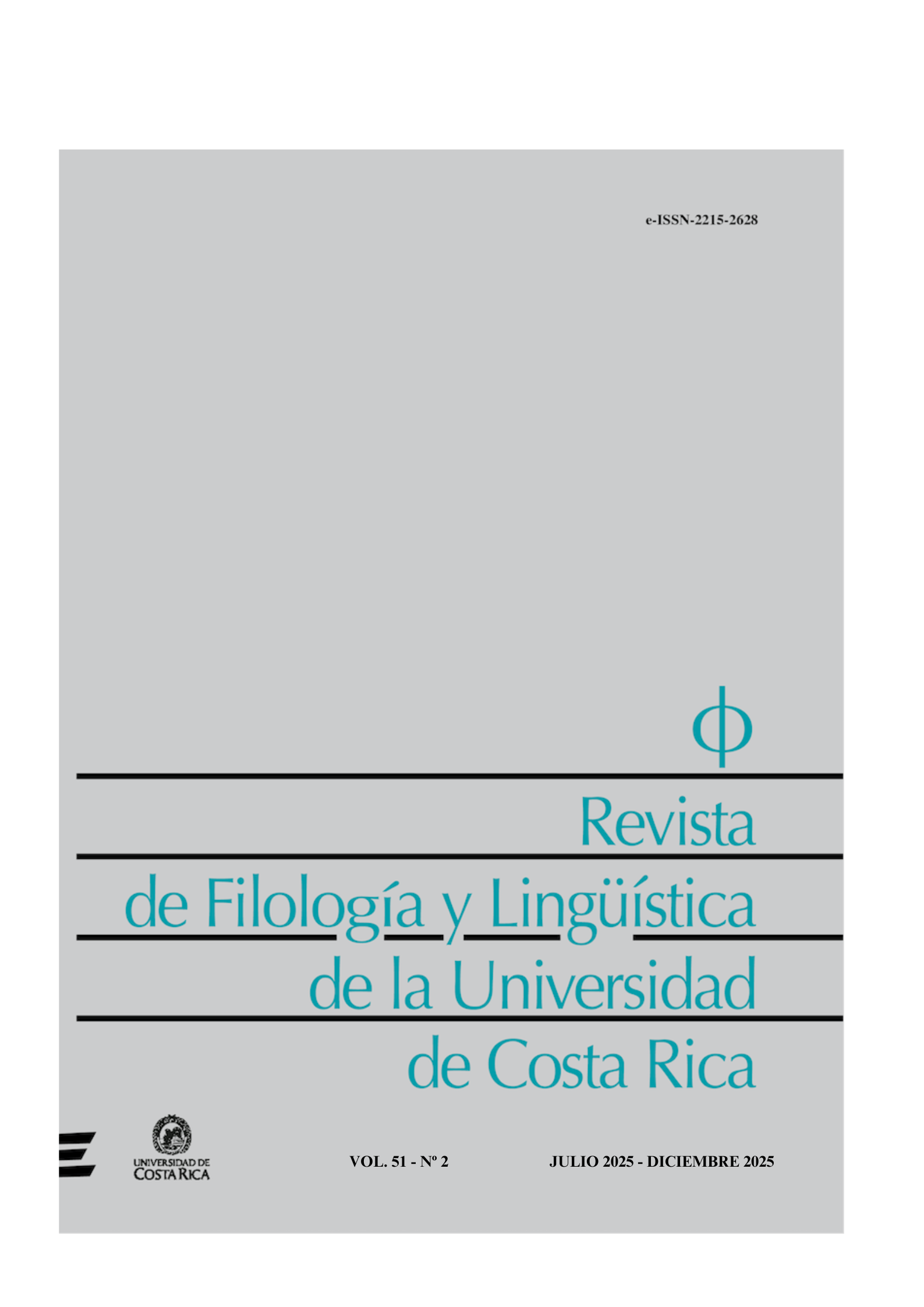Deber y deseo en voz de una demonesa: la historia de Hiḍimbā en el Mahābhārata
DOI:
https://doi.org/10.15517/x4qcma70Palabras clave:
Hiḍimbā, demonios, mujeres, Dharma, MahābhārataResumen
Este artículo estudia la historia de la demonesa Hiḍimbā, presente en cinco capítulos de la epopeya sánscrita El Mahābhārata (1.139-143). Este episodio destaca cómo una mujer de linaje inferior, desde una perspectiva brahmánica, logra reconfigurar la perspectiva del dharma gracias a que ella, quien siendo una demonesa, se enamora de un humano. En la actualidad, la historia de Hiḍimbā sigue siendo relevante, ya que invita a reflexionar sobre la naturaleza de lo demoníaco, el rol de las mujeres en las sociedades de la India, la interpretación del amor y las uniones desiguales en una cultura profundamente estratificada. También permite explorar cómo un personaje femenino puede desarrollarse y dejar huella a pesar de su origen o de las barreras que enfrenta para alcanzar sus objetivos. De este modo, la historia de Hiḍimbā ha dado origen al culto de la diosa-demonio en la ciudad de Manali, India.
Descargas
Referencias
Banerjee, M. (2015). Rakshasas and Asuras in Hindu epic tales. IJASOS-International E-Journal of Advances in Social Sciences, 1(2). DOI: https://doi.org/10.18769/ijasos.90709
Bhatt, G. H. y Shah, U. P. (Eds.) (1960-1975). The Vālmīki Rāmāyaṇa (7 vols). Baroda Oriental Research Institute.
Bowles, A. (2007). Dharma, Disorder and the Political in Ancient India. The Āpaddharmaparvan of the Mahābhārata. Brill. DOI: https://doi.org/10.1163/ej.9789004158153.i-432
Battacharya, N. N. (2000). Indian demonology: The inverted pantheon. Manohar.
Doniger, W. (1988). The origins of evil in Hindu mythology. Motilal Banarsidass.
Figueroa, Ó. (2022). El loto en el estanque. Canon y diversidad en la India clásica. Universidad Nacional Autónoma de México. DOI: https://doi.org/10.22201/crim.9786073058742p.2022
Figueroa, Ó. y López Olivares, L. J. (Trads.). [manuscrito en preparación]. Mahābhārata 1.139-143: la historia de Hiḍimbā, la demonesa que se enamoró de un humano. Revista Estudios de Asia y África.
Halperin, E. (2019). Is the Goddess Hiḍimbā Tantric? Negotiating power in a Western Himalayan sacrificial arena. International Journal of Hindu Studies, 23(2), 195-212. DOI: https://doi.org/10.1007/s11407-019-09259-y
Hamilton, E. (1998). Mythology: Timeless tales of gods and heroes. Black Bay Books.
Hiltebeitel, A. (2011a). Dharma: Its early history in law, religion, and narrative. Oxford University Press.
Hiltebeitel, A. (2011b). When the Goddess was a Woman. En V. Adluri y J. Bagchee (Eds.), When the Goddess was a Woman (pp. 243-274). Brill.
Jain, V. (2022). Manali was the filming location of these 5 popular Bollywood movies. Curly Tales. https://curlytales.com/manali-was-the-filming-location-of-these-5-popular-bollywood-movies/
McGrath, K. (2009). Strī: Women in epic Mahābhārata. Ilex Foundation; Center for Hellenic Studies, Trustees for Harvard University.
Narain, U. (2003). Resurrecting the mother in ‘Mata Hidimba’. Economic and Political Weekly, 38(17), 1680-1683.
Olivelle, P. (2005). (Trad.). Manu’s code of law: A critical edition and translation of the Mānava-Dharmaśāstra. Oxford University Press. DOI: https://doi.org/10.1093/oso/9780195171464.001.0001
Ram-Prasad, C. (2018). Human being, bodily being. Oxford University Press. DOI: https://doi.org/10.1093/oso/9780198823629.001.0001
Ramanujan, A. K. (1982). On women saints. En J. Stratton Hawley & D. M. Wulff (Eds.), The divine consort: Rādhā and the goddesses of India (pp. 316-324). Berkeley Religious Studies Series.
Sharma, D. (2021). Animal sacrifice in shrines of Himachal: Question of belief and rationality. Himachal Watcher. https://himachalwatcher.com/2021/11/03/animal-sacrifice-in-shrines-of-himachal-question-of-belief-and-rationality/
Špicová, Z. (2023). Ancient Indian laws of war. In S. White (Ed.), The laws of yesterday’s wars 2 (pp. 5-44). Brill. https://doi.org/10.1163/9789004473218_003 DOI: https://doi.org/10.1163/9789004473218_003
Sutton, N. (2000). Religious doctrines in the Mahābhārata. Motilal Banarsidass Publishers.
Sutton, N. (2005). What is Dharma? Ethical tensions within the Mahābhārata. En T. S. Rukmani (Ed.), The Mahābhārata: What is not here is nowhere else (Yannehāsti na Tadkvacit) (pp. 91-102). Munshiram Manoharlal Publishers.
Descargas
Publicado
Número
Sección
Licencia
Derechos de autor 2025 Lucero Jazmín López Olivares (Autor/a)

Esta obra está bajo una licencia internacional Creative Commons Reconocimiento-NoComercial-SinObraDerivada 3.0.
Aquellos autores/as que tengan publicaciones con esta revista, aceptan los términos siguientes:
- Los autores/as conservarán sus derechos de autor y garantizarán a la revista el derecho de primera publicación de su obra, el cual estará simultáneamente sujeto a la Licencia de reconocimiento de Creative Commons 3.0 (Atribución - NoComercial - SinDerivadas) que permite a terceros compartir la obra siempre que se indique su autor y su primera publicación en esta revista, respetando la restricción de uso comercial y de generación de obra derivada.
- Los autores/as podrán adoptar otros acuerdos de licencia no exclusiva de distribución de la versión de la obra publicada (p. ej.: depositarla en un archivo telemático institucional o publicarla en un volumen monográfico) siempre que se indique la publicación inicial en esta revista.
- Se permite y recomienda a los autores/as difundir su obra a través de Internet (p. ej.: en archivos telemáticos institucionales o en su página web) antes y durante el proceso de envío, lo cual puede producir intercambios interesantes y aumentar las citas de la obra publicada. (Véase El efecto del acceso abierto).



1.png)



